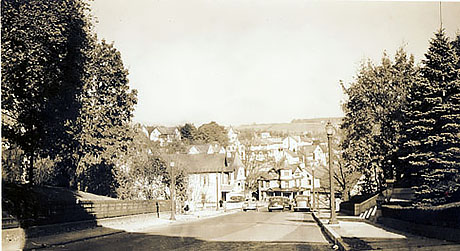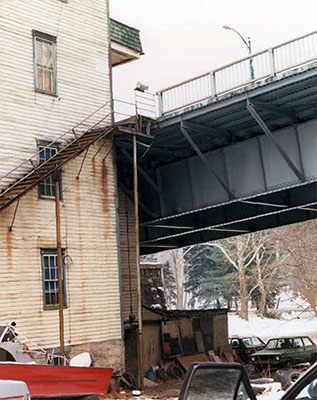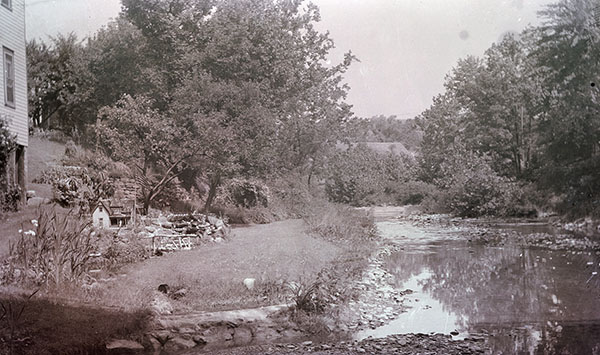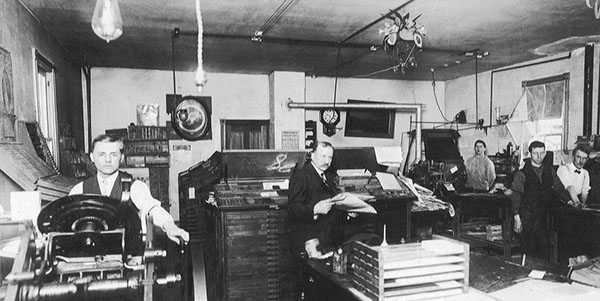The construction of a building for James G. Rauch’s The Slatington News coincided with the replacement of the Main Street Bridge over Trout Creek. In February 1900, at a borough council meeting, the borough solicitor was directed to draw up a petition for a new bridge. At the very same time, Rauch asked for line and grade on Main Street, along the north side of the old Trout Creek Bridge. That meant that he had already acquired the property immediately to the north of the old bridge and was thinking of building a newspaper office there. The property that he purchased was sandwiched between Trout Creek on the east and the Slatedale Branch of the Lehigh Valley Railroad on the west. The property was long and narrow and had no real street access, and so it must have been a relatively cheap purchase from the estate of Henry Kuntz.
By August 1900, Lehigh County had agreed to build a new bridge, and contracts had been awarded. The new bridge was constructed of steel, 180 ft. long and 42 ft. wide, with a sidewalk of 10 ft., road space of about 20 ft. and the rest of the width reserved for Lehigh Transit Company trolley tracks. With everything in place by the fall of 1900, construction began on the bridge. Sometime in that time frame, Rauch designed his news building, and he had the idea to have the newspaper office level with the sidewalk on the bridge. “The location afforded James Rauch's newsroom on the third floor a strategic position in the borough, being located on the bridge, the principal connection between the upper half of the borough to the west of Trout Creek, and the lower half to the east of the Creek.” (Pennsylvania Historical Resource Survey Form, 1988)
In August 1901, just a year later, The Slatington News was occupying its new building alongside the “new” Main Street Bridge. The address was 420 Main Street.
The new quarters were described as “better equipped than ever” in a building that had all the most modern improvements. “Our compositing and job departments occupy the third floor, while the press department occupies the second floor. There are two other floors and a basement remaining. The fourth floor contains 3 large offices, one of which has already been rented. The basement and first floor are very convenient for some manufacturing plant, as the railroad facilities are excellent.” (The Slatington News, 24 August 1901)

Another older view of the bridge area looking east down the Main Street Bridge
The structure was tall and narrow (I always remember it as painted a shade of yellow.) with the third floor (the main newspaper office) aligning with the sidewalk of the bridge. There was a garage and an addition of two stories that extended under the bridge. There was also a three-story addition to the back of the building. The building was a rather utilitarian, wooden frame structure with a slate roof (naturally). Most of the windows were four over four panes, double-hung. There was a large picture window on the third-floor office, looking out onto the bridge.
The photo below gives some idea of the massive size of the wooden-frame building.

Source: Pennsylvania Historical Resource Survey Form
The internal arrangement of the building changed slightly over time. From the Pennsylvania historical resource survey:
The Sanborn map of 1902 lists the functions of the various floors as a clubroom on the first, press room on the second, composing room on the third (the third floor being level with the bridge), and the office on the fourth. By 1913, the Sanborn map indicated the building had been both extended to the rear and to the front under the bridge. A dwelling was located on the first floor, as well as a press room, which according to James Rauch was located in an addition under the bridge, a set of doors being all that separated it from the dwelling. The first-floor location for the flatbed press was necessary because of its great weight. Printing and composing functions were located on the third floor and offices on the fourth. By 1927 the Sanborn map shows the dwelling and press functions were continued on the first floor, with the composing on the third, but the fourth floor had become a dwelling unit. In later years, according to James Rauch, the first floor served as the family's dwelling, while the second floor served as storage for both the newspaper and the dwelling, the third floor contained the newspaper office, with the editor's desk and the addressograph machine, and the fourth floor with an apartment.”
Mary Ann Hannagan, a great-granddaughter of James G. Rauch, also recalled that:
The Rauchs lived on the bottom level (first floor living quarters), and the press was also on the ground level in the back of the building. The second floor was a small room. It had a ticket punch machine. The top floor (3rd floor, office in front, typesetting) was built at the same time as the bridge so that they were on the same level. The front office had a large picture window facing the street. It held a large table. The office also had a roll top deck. Behind the office was where the paper was put together. The Linotype machine was in the back, in the right corner. They had a large paper cutter in the front of the room and also a hand-bill printer. This was an antique Washington press and at one time it was located in the Lehigh County Historical Society’s Museum. It is now in Slatington’s borough hall. Behind this room was a sun porch that held all of the wooden picture plates that they would reuse. The top floor (the 4th floor) of the building was an apartment that they rented out.
Let me mention a few other things about the building.
On the west side of the building, there was a long staircase from the ground up to the bridge level. I am not sure exactly when it was installed, but it must have been added when the apartments were installed in the building. When I was young, I was able to use the staircase a few times. It was rather flimsy and quite scary to climb.

Source: Pennsylvania Historical Resource Survey Form
The Rauchs also had a garden with a miniature house on the east side of the building, next to Trout Creek.

1938 photo of the Rauch family garden
You can just see the miniature house in the middle of the garden. Rauch had the miniature house built with a slate roof that he could use at trade shows to promote the slate industry. After all, he was a slate entrepreneur in addition to his publishing work.
Rauch was part of the ownership of the Blue Valley quarry aka the Reservoir Quarry. According to Slate in Pennsylvania (1933), the quarry, which first opened in 1875, was 685 ft. x 400 ft. (That’s large!) and located just east of Rextown, across from the Slatington reservoir. As was typical with a lot of slate operations, the quarry passed through many hands and different ownership groups over the years; operations started and then were suspended; the quarry filled with water and then was pumped out when operations resumed; there were fires; there were people killed and injured in accidents. I am not sure when exactly in the 1930s the quarry finally ceased operations.
All in all, Rauch’s newspaper office was an amazing building in the very center of the town. Besides the weekly newspaper, the company also did contract printing work for schools, churches, mills and other small businesses. It printed letterheads, wedding invitations, business cards, calendars, and bills and vouchers, and supplied small amounts of paper for smaller jobbers in the area. James Rauch was a photographer who had his own darkroom for the developing of wet plates, and he provided pictures to the The Morning Call newspaper in Allentown.

View of the third-floor office space with James G. Rauch, center, and Oliver Rauch to the left
So, what happened to the building? Well, the newspaper was published there until 1967 when it was sold to H. Boyd and Joe Nanovic of Palmerton. For a short while, The News Publishing Company continued to own the building and do some commercial printing work. But by the late 1970s, it had been turned into an apartment building. Below is a photo of the building in its later apartment stage.

Source: Pennsylvania Historical Resource Survey Form
In April 1992, Slatington learned that the state was considering plans to replace the Main Street Bridge that carried Route 873 over Trout Creek. Yes, that’s the same bridge that was erected back in 1901 at the same time that the news building was built. (The bridge had most recently been upgraded in 1948 and 1977!) But before any construction could take place, a historical assessment of both the bridge and the building had to take place. Because the building was part of the Slatington historic district, “The building’s historic designation snagged bridge replacement plans, because PennDOT [Pennsylvania Department of Transportation] had to make every effort save it.” PennDot’s Stephen Caruano said a study showed excavation for bridge construction would make the building unsafe. An environmental impact also had to be undertaken. (20 July 1998, The Morning Call)
When a meeting was held in the Slatington High School to discuss bridge plans, earlier plans to replace just the bridge decking and to reuse the original bridge abutments changed. It was then proposed to build a completely new bridge. The newspaper building would have to be removed.
Ten years later, The Morning Call headline read “Slatington Still Waiting for New Bridge.” Borough Council President Marie Fister said, “They just seem to have ignored us.” Gary Diaz, who was the owner of the Slatington News building, now turned into apartments, wanted to renovate the building, and he was in litigation with PennDOT. (23 Jan 2002, The Morning Call)
The bridge project moved slowly forward. By October 2002, PennDOT had finally agreed to buy the Slatington News Building, which was going to be razed to make way for the new bridge. The photo in the newspaper showed a building that looked terrible. The price was set at $81,000 for the building that had been bought by Gary and Lucille Diaz in January 1988 for $49,500. (7 Oct 2002, The Morning Call)
In March 2006, “Slatington Eyes Light at End of the Tunnel,” read the newspaper headline with construction now set for the following year. With the bridge out of commission, various detour routes had to be planned, including one 17-mile detour for large trucks. (2 Mar 2006, The Morning Call)
Still, it wasn't until April 2008 that the bridge replacement work finally began. Road-Con of West Chester, PA was handling the demolition and then the construction of the new two-span, concrete-box, beam bridge. Plans had again been delayed because of a new problem with a temporary pedestrian bridge (See, The Morning Call 17 January 2008, 20 March 2008, 25 March 2008, 9 April 2008). The new General Thomas R. Morgan Bridge formally opened with a ribbon cutting ceremony on 12 December 2008. (13 Dec 2008, The Morning Call)
The Slatington News building was no longer in existence.
This building was always part of my neighborhood. If we were down below bridge level, fishing, hanging out or playing some games, the building loomed over us, three stories high. If you were walking up or down the bridge, you could always look into the office of the newspaper through the front window. It was just a massive wood-frame building, and I would certainly have liked a chance to check out its internal structure before it was torn down.

Current (2023) view of the Main Street bridge area in Slatington
